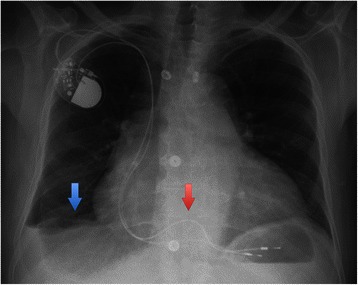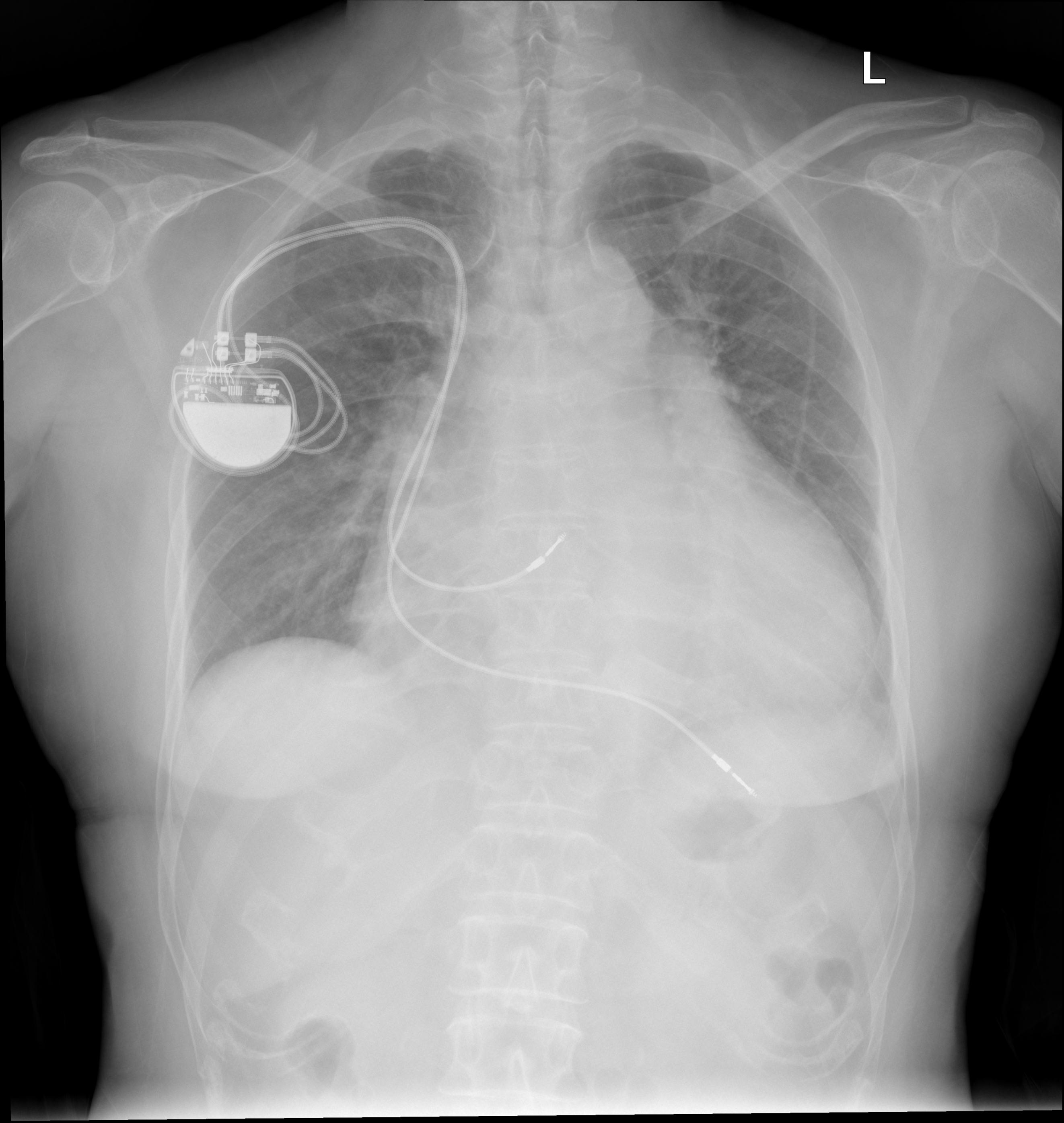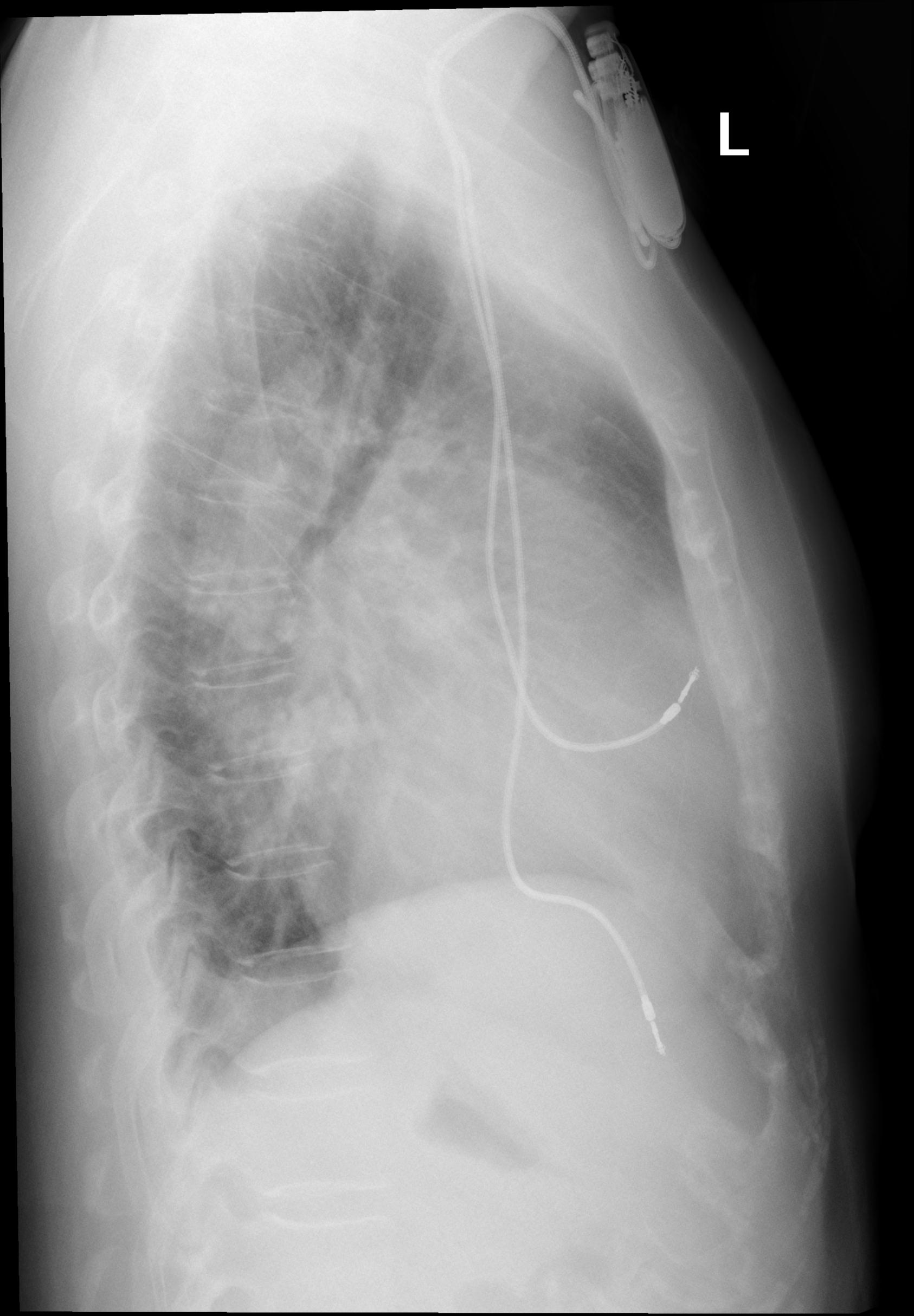Tricuspid regurgitation chest x ray: Difference between revisions
(→X ray) |
|||
| (8 intermediate revisions by the same user not shown) | |||
| Line 1: | Line 1: | ||
__NOTOC__ | __NOTOC__ | ||
{{Tricuspid regurgitation}} | {{Tricuspid regurgitation}} | ||
{{CMG}} {{AE}} {{Rim}} {{FB}} | {{CMG}} ; {{AE}} {{VKG}} ; {{Rim}} ; {{FB}} | ||
==Overview== | ==Overview== | ||
An [[Chest X-ray|chest x-ray]] may be helpful in the [[diagnosis]] of [[tricuspid regurgitation]] during the initial evaluation as well as during follow-up among [[adolescent]] and young adult patients. Findings on an [[x-ray]] suggestive of [[tricuspid regurgitation]] include [[cardiomegaly]], prominent [[cardiac]] silhouette, [[Right atrium|right atrial]] enlargement and [[pleural effusion]]. | |||
== X ray == | == X ray == | ||
An [[Chest X-ray|chest x-ray]] may be helpful in the [[diagnosis]] of [[tricuspid regurgitation]]. Findings on an [[Chest X-ray|chest x-ray]] suggestive [[tricuspid regurgitation]] include:<ref name="pmid26503944">{{cite journal| author=Tornos Mas P, Rodríguez-Palomares JF, Antunes MJ| title=Secondary tricuspid valve regurgitation: a forgotten entity. | journal=Heart | year= 2015 | volume= 101 | issue= 22 | pages= 1840-8 | pmid=26503944 | doi=10.1136/heartjnl-2014-307252 | pmc=4680164 | url=https://www.ncbi.nlm.nih.gov/entrez/eutils/elink.fcgi?dbfrom=pubmed&tool=sumsearch.org/cite&retmode=ref&cmd=prlinks&id=26503944 }}</ref> | |||
*[[Cardiomegaly]] can be noticed when the [[tricuspid regurgitation]] is severe due to [[right ventricle]] enlargement | |||
*[[Cardiac]] silhouette can be noticed on the right in the [[x-ray]] along with the [[pulmonary artery]] view | |||
*[[Right atrium|Right atrial]] enlargement can be noticed | |||
*A view of [[azygos vein]] can be seen when the pressure is elevated in the [[right atrium]] | |||
*[[Pleural effusion|Pleural effusions]] can be noticed | |||
* Cardiac silhouette can be noticed on the right in the x-ray along with the pulmonary artery view | *An upward displacement of the [[diaphragm]] can be noticed due to [[ascites]] | ||
* Right atrial enlargement can be noticed | *Prominent right and left [[pulmonary artery]] [[hilar]] segments can be noticed on the [[x-ray]] | ||
*A view of azygos vein can be seen when the pressure is elevated in the right atrium | |||
*Pleural effusions can be noticed | |||
*An upward displacement of the diaphragm can be noticed due to ascites | |||
*Prominent right and left pulmonary artery hilar segments can be noticed on the | |||
==2008 ACC/AHA Guidelines for the Management of Patients with Valvular Heart Disease - Evaluation of Tricuspid Valve Disease in Adolescents and Young Adults (DO NOT EDIT)<ref name="pmid18820172">{{cite journal |author=Bonow RO, Carabello BA, Chatterjee K, ''et al.'' |title=2008 Focused update incorporated into the ACC/AHA 2006 guidelines for the management of patients with valvular heart disease: a report of the American College of Cardiology/American Heart Association Task Force on Practice Guidelines (Writing Committee to Revise the 1998 Guidelines for the Management of Patients With Valvular Heart Disease): endorsed by the Society of Cardiovascular Anesthesiologists, Society for Cardiovascular Angiography and Interventions, and Society of Thoracic Surgeons |journal=Circulation |volume=118 |issue=15 |pages=e523–661 |year=2008 |month=October |pmid=18820172 |doi=10.1161/CIRCULATIONAHA.108.190748 |url=}}</ref>== | ==2008 ACC/AHA Guidelines for the Management of Patients with Valvular Heart Disease - Evaluation of Tricuspid Valve Disease in Adolescents and Young Adults (DO NOT EDIT)<ref name="pmid18820172">{{cite journal |author=Bonow RO, Carabello BA, Chatterjee K, ''et al.'' |title=2008 Focused update incorporated into the ACC/AHA 2006 guidelines for the management of patients with valvular heart disease: a report of the American College of Cardiology/American Heart Association Task Force on Practice Guidelines (Writing Committee to Revise the 1998 Guidelines for the Management of Patients With Valvular Heart Disease): endorsed by the Society of Cardiovascular Anesthesiologists, Society for Cardiovascular Angiography and Interventions, and Society of Thoracic Surgeons |journal=Circulation |volume=118 |issue=15 |pages=e523–661 |year=2008 |month=October |pmid=18820172 |doi=10.1161/CIRCULATIONAHA.108.190748 |url=}}</ref>== | ||
| Line 52: | Line 28: | ||
|} | |} | ||
[[File:Pleural effusion in TR.jpg|alt=pleural effusion|center|thumb|358x358px|'''Preoperative chest X-ray.''' Blue arrow: pleural effusion; Red arrow: different course of the two leads through the tricuspid valve. Case courtesy by Martin Andreas et al<ref>{{Cite web|url=https://www.ncbi.nlm.nih.gov/pmc/articles/PMC4374532/|title=Case report: Pacemaker lead perforation of a papillary muscle inducing severe tricuspid regurgitation|last=|first=|date=|website=|archive-url=|archive-date=|dead-url=|access-date=}}</ref>]] | |||
[[File:Right-atrial-enlargement in Tricuspid regurgitation .jpg|alt=Right-atrial-enlargement in Tricuspid regurgitation|center|thumb|633x633px|Right-atrial-enlargement in Tricuspid regurgitation . Case courtesy of Dr Henry Knipe, <a href="https://radiopaedia.org/">Radiopaedia.org</a>. From the case <a href="https://radiopaedia.org/cases/30186">rID: 30186</a>]] | |||
[[File:Right-atrial-enlargement lateral view.jpg|alt=Right-atrial-enlargement lateral view|center|thumb|864x864px|'''Right-atrial-enlargement lateral view'''.Case courtesy of Dr Henry Knipe, <a href="https://radiopaedia.org/">Radiopaedia.org</a>. From the case <a href="https://radiopaedia.org/cases/30186">rID: 30186</a>]] | |||
<br /> | |||
==References== | ==References== | ||
{{reflist|2}} | {{reflist|2}} | ||
Latest revision as of 12:44, 28 April 2020
|
Tricuspid Regurgitation Microchapters |
|
Diagnosis |
|---|
|
Treatment |
|
Case Studies |
|
Tricuspid regurgitation chest x ray On the Web |
|
American Roentgen Ray Society Images of Tricuspid regurgitation chest x ray |
|
Risk calculators and risk factors for Tricuspid regurgitation chest x ray |
Editor-In-Chief: C. Michael Gibson, M.S., M.D. [1] ; Associate Editor(s)-in-Chief: Vamsikrishna Gunnam M.B.B.S [2] ; Rim Halaby, M.D. [3] ; Fatimo Biobaku M.B.B.S [4]
Overview
An chest x-ray may be helpful in the diagnosis of tricuspid regurgitation during the initial evaluation as well as during follow-up among adolescent and young adult patients. Findings on an x-ray suggestive of tricuspid regurgitation include cardiomegaly, prominent cardiac silhouette, right atrial enlargement and pleural effusion.
X ray
An chest x-ray may be helpful in the diagnosis of tricuspid regurgitation. Findings on an chest x-ray suggestive tricuspid regurgitation include:[1]
- Cardiomegaly can be noticed when the tricuspid regurgitation is severe due to right ventricle enlargement
- Cardiac silhouette can be noticed on the right in the x-ray along with the pulmonary artery view
- Right atrial enlargement can be noticed
- A view of azygos vein can be seen when the pressure is elevated in the right atrium
- Pleural effusions can be noticed
- An upward displacement of the diaphragm can be noticed due to ascites
- Prominent right and left pulmonary artery hilar segments can be noticed on the x-ray
2008 ACC/AHA Guidelines for the Management of Patients with Valvular Heart Disease - Evaluation of Tricuspid Valve Disease in Adolescents and Young Adults (DO NOT EDIT)[2]
| Class I |
| "1. Chest X-ray is indicated for the initial evaluation of adolescent and young adult patients with TR, and serially every 1 to 3 years, depending on severity. (Level C)" |



References
- ↑ Tornos Mas P, Rodríguez-Palomares JF, Antunes MJ (2015). "Secondary tricuspid valve regurgitation: a forgotten entity". Heart. 101 (22): 1840–8. doi:10.1136/heartjnl-2014-307252. PMC 4680164. PMID 26503944.
- ↑ Bonow RO, Carabello BA, Chatterjee K; et al. (2008). "2008 Focused update incorporated into the ACC/AHA 2006 guidelines for the management of patients with valvular heart disease: a report of the American College of Cardiology/American Heart Association Task Force on Practice Guidelines (Writing Committee to Revise the 1998 Guidelines for the Management of Patients With Valvular Heart Disease): endorsed by the Society of Cardiovascular Anesthesiologists, Society for Cardiovascular Angiography and Interventions, and Society of Thoracic Surgeons". Circulation. 118 (15): e523–661. doi:10.1161/CIRCULATIONAHA.108.190748. PMID 18820172. Unknown parameter
|month=ignored (help) - ↑ "Case report: Pacemaker lead perforation of a papillary muscle inducing severe tricuspid regurgitation".